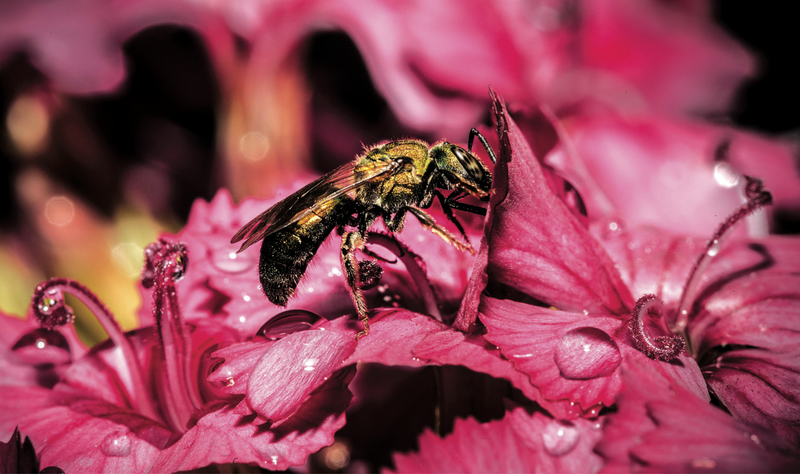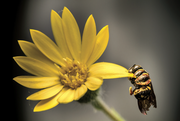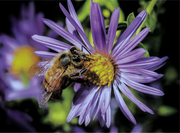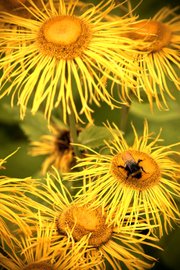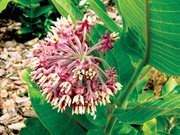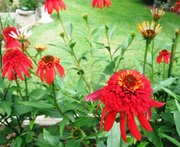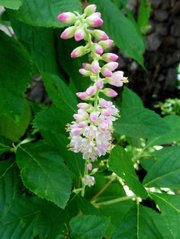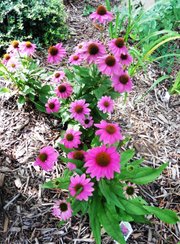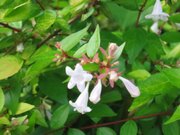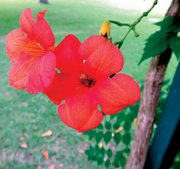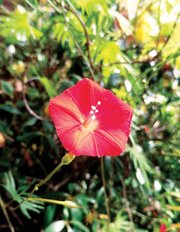Plant pollination is pretty important to humans. An estimated one-third of humanity's food depends on pollination. It ensures that we have fruits and vegetables to eat, coffee to drink, chocolate to nibble on and tequila for margaritas.
The animals we eat also depend on plants that cannot reproduce without help from pollinators -- insects or animals that physically cause a plant's pollen grains to fertilize its female parts.
Bees are the leading pollinators, but they get help from butterflies, hummingbirds, bats and a few other insects, such as beetles and flies.
Population declines among bees have caused widespread alarm. Entomologists say that damaging mites, loss of overwintering habitat and misuse of pesticides are all culprits in the decline of bees; but another factor is a decline in the ready availability of pollinator-attracting plants -- and that is an easy problem to fix.
Gardeners can grow more of the plants that attract and support pollinators. Different types of pollinators have different preferences for blooms. So, to draw as many pollinators as possible, grow a diversity of species.
DIFFERENT TASTES
Pollinators are attracted by sweet nectar and nutritious pollen, and they find the flowers through flower color and fragrance as well as the shape and the size of the bloom.
• Bees cannot see the color red, so they tend to look for white, yellow and purple flowers. They like a mild, sweet-smelling bloom, and they like a bloom with a landing platform for them to rest on while they are feasting on nectar.
• Butterflies prefer bright red and purple blooms, but will go to others; they like a wide landing area and a narrow, tubed flower with nectar. Butterflies also need more from plants than nectar for the adult butterfly; they also need places to lay eggs, leaves for their larvae (caterpillars) to eat, and places to form chrysalides -- the hardened cases in which butterfly pupa develop.
• Hummingbirds like red and orange flowers, especially with tubular blooms.
• Bats typically go after white-blooming plants with flowers that are open at night and have bowl-shaped blooms and a somewhat musty smell.
• Beetles tend to like bowl-shaped flowers that are white or green and strongly fruity in fragrance, although some like a more fermented smell.
• Flies are highly attracted to flowers that are pale and dull in color and have a rotted meat or putrid smell -- which is not the most appealing aroma for gardeners. Some species of plants trap the insects temporarily to ensure the gathering and transfer of pollen (such as the Venus flytrap).
FOUR SEASONS
Regardless of which pollinators you want to attract, make sure you have something blooming in every season. Some plants will have more than one pollinator attracted to them, while others are very specific.
Pollinator-attracting plants can include annual flowers, vegetables, fruit trees and bushes, perennials, trees and shrubs. Just having a pretty flower doesn't mean it is a good pollinator plant. Forsythia and tulip magnolia are showy plants that are fairly worthless to pollinators.
Winter: Camellias, rosemary, winter jasmine, hellebores and mahonia are great sources of nectar and pollen for bees. Butterflies and hummingbirds are not very active in cool months but will start coming in late winter and last into late fall.
Spring: Fruit trees of all forms are great attractors as spring progresses, along with sugar, red and silver maple trees. Other trees that are popular with pollinators include pussy willows, Carolina buckthorn, black locust, linden trees, redbud, tulip poplar and blackgum trees.
Summer: Crape myrtles, vitex, and golden raintree are bee magnets. Shrubs for bees include flowering quince, daphne, cotoneaster, roses, glossy abelia, callicarpa (French mulberry), hydrangeas, clethra, cherry laurel and elderberries.
For perennials, start the season with hellebores and add peonies, baptisia, bee balm, butterfly weed, catmint, coneflower, black-eyed Susan, agastache, salvia and lobelia.
Fall: For color that attracts bees and butterflies, try goldenrod, aster, chrysanthemums, Japanese anemone, sedums and joe-pye weed. For annuals, consider bachelor buttons, salvia, cosmos, lantana, ageratum, sunflowers and snapdragons.
HUMOR THE HUMMERS
Hummingbirds love columbine, flowering quince, trumpet honeysuckle, red buckeye, red bee balm, red pentas, cardinal flower lobelia, trumpet creeper, agastache, liatris, lantana, Turk's cap, morning glory, cypress vine, hosta blooms, beard tongue (penstemon) and yucca.
BETTER THE BATS
Bats are more important pollinators in the rain forest or in tropical areas, where they pollinate bananas, mangoes and dates.
In other climates, many cactus species are dependent on bat pollination and thus bloom only at night. The agave bloom is pollinated by bats, and agave is where we get tequila.
Even though we don't grow many banana and cactus plants, we can attract bats in Arkansas by planting showy evening primrose, phlox, moonflower and four-o'clocks. Late in the season, they are attracted to goldenrod, which is also great for bees and butterflies.
THRILL THE FLIES
The Jack in the pulpit flower, skunk cabbage and the pawpaw are all off-smelling blooms that attract flies and beetles.
If you want to wow your neighbors, plant the giant Amorphophallus konjac, or voodoo lily, which grows 4 to 5 feet tall. There are shorter varieties of Amorphophallus that also have an interesting bloom and are quite pungent -- and not necessarily in a good way.
Plants in the genus Stapelia are also called "carrion flowers." They are small, spineless, cactus-like succulent plants with interesting blooms. They all attract mostly scavenging flies and beetles as pollinators with their unique aroma.
Diversity is key if you want a variety of pollinators in your garden, or even if you want only bees and butterflies all season long.
In addition to flowers, don't forget water and habitat. With some effort, you can help support and protect our pollinators.
HomeStyle on 07/18/2015
